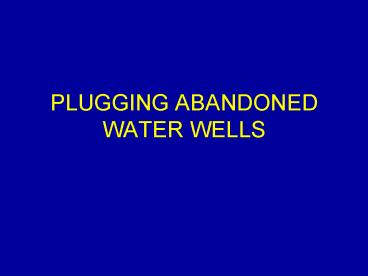PLUGGING ABANDONED WATER WELLS - PowerPoint PPT Presentation
1 / 17
Title:
PLUGGING ABANDONED WATER WELLS
Description:
PLUGGING ABANDONED WATER WELLS. Introduction. Abandoned water wells ... Removes annular space around well. Allows native soil to bond with plugging materials. ... – PowerPoint PPT presentation
Number of Views:112
Avg rating:3.0/5.0
Title: PLUGGING ABANDONED WATER WELLS
1
PLUGGING ABANDONED WATER WELLS
2
Introduction
- Abandoned water wells as a risk to our
- Safety
- Water supply
- How can we plug these abandoned wells.
3
Introduction
- Have you seen an abandoned well?
- If so what was the condition of the well.
- Was it covered?
- How easy would it have been to fall in?
4
Well Plugging Video
- This video was created through a joint effort by
the Texas Cooperative Extension and the Texas
Groundwater Protection Committee.
5
Why are Wells a Treat?
- Open hole that a person can fall into and be
injured. - Provide a direct conduit for surface water to be
carried down t the groundwater resource. - Provide a means for the groundwater from two
different aquifers t be mixed.
6
Abandoned Well?
- If the well is not considered in use for six
months. - A well is considered in use if it
- has a good casing, pump and pump column.
- has a non-deteriorated well casing that has been
capped.
7
Plugging Materials
- Bentonite clay.
- Chips and Slurry
- Cement slurry.
- Hand dug wells can be filled with a good clay
soil or caliche soil.
8
Key Steps to Plug an Abandoned Well
- Measure the dimensions of the well.
- Remove all obstructions from the well.
- Disinfect the well by adding household bleach.
- Remove as much casing as possible.
- Fill the well with plugging materials.
- Complete the plugging report.
9
Step One
- Measure the dimensions of the well.
- Determine the volume of plugging material needed
to plug the well - Determine the quantity of standing water in the
well.
10
Step Two
- Remove all obstructions from the well.
- Prevent plugging materials from reaching the
bottom of the well. - Potential for future settling an disturbance of
seal.
11
(No Transcript)
12
Step Three
- Disinfect the well by adding household bleach.
- Kills any microorganisms in the well water.
- Prevents sealing of microorganisms in the aquifer.
13
Step Four
- Remove as much casing as possible.
- Removes direct conduit to the groundwater.
- Removes annular space around well.
- Allows native soil to bond with plugging
materials.
14
Step Five
- Fill the well with plugging materials.
- Restrict water movement from the soil surface to
the groundwater. These materials need to be
clean to prevent contamination of the groundwater
and prevent bridging as the materials enter the
well.
15
Step Six
- Complete the plugging report.
- The plugging report provides documentation that
the well has been properly plugged. This material
needs to be sent to the Texas Department of
Licensing and Regulation and local groundwater
districts.
16
Conclusion
- Abandoned wells are a danger for falling into the
well provide a direct conduit for contaminants to
reach groundwater. - A well is considered abandoned if it is not used
for six months and has a deteriorated casing, or
inoperable. - The well will not be considered abandoned if it
is capped, returned to an operable status or is
plugged.
17
Conclusion
- To properly plug an abandoned well you need to
fallow the six key steps in the plugging process.































